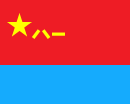Peoples Liberation Army Air Force
| People's Liberation Army Air Force 中国人民解放军空军 |
|
|---|---|

People's Liberation Army Air Force emblem
|
|
| Founded | November 11, 1949 |
| Country |
|
| Allegiance | Communist Party of China |
| Branch | People's Liberation Army |
| Type | Air force |
| Role | Aerial warfare |
| Size | 398,000 active personnel Approx. 2,755 to 3,010+ aircraft |
| Engagements | Korean War, Vietnam War, Sino-Vietnamese War |
| Commanders | |
| Commander | General Ma Xiaotian |
| Political Commissar | Lt Gen Yu Zhongfu |
| Insignia | |
| Flag |  |
| Roundel |  |
| Low Visibility Roundel |  |
| Aircraft flown | |
| Attack | Q-5, JH-7 |
| Bomber | JH-7, H-6 |
| Electronic warfare |
KJ-200, KJ-500, KJ-2000, TU-154 |
| Fighter | J-7, J-8, J-10, J-11, J-16, J-20, Su-27, Su-30MKK, Su-35S |
| Helicopter | Z-8, Z-9 |
| Interceptor | J-8II |
| Trainer | L-15, JL-8, JL-9 |
| Transport | Y-20, Y-9, Y-8, Y-7, Il-76 |
| Tanker | H-6U, Il-78 |
| People's Liberation Army Air Force | |||||||
| Simplified Chinese | 中国人民解放军空军 | ||||||
|---|---|---|---|---|---|---|---|
| Traditional Chinese | 中國人民解放軍空軍 | ||||||
|
|||||||
| Transcriptions | |
|---|---|
| Standard Mandarin | |
| Hanyu Pinyin | Zhōngguó Rénmín Jiěfàngjūn Kōngjūn |
The People's Liberation Army Air Force (PLAAF) is the aerial warfare service branch of the People's Liberation Army, the armed forces of the People's Republic of China. The PLAAF was officially established on 11 November 1949. As of 2014, the PLAAF has a strength of around 398,000 personnel and is the largest air force in Asia. With ongoing modernisation, all older aircraft types in service are quickly being phased out and emphasis being placed on developing modern 4.5th generation fighters to replace them - along with 5th generation fighters in the near future.
The PLA's first organized air unit, was formed in July 1949 at Beijing Nanyuan Airport. It consisted of six P-51s, two Mosquitoes, and two PT-19s. On 25 October 1949, Liu Yalou was appointed as the chief of air force in the People's Liberation Army. By 11 November, the air force command was officially formed from the headquarters of Liu Yalou's 14th bingtuan (which Witson translates as "Army"). Much Soviet assistance was received to help the process along.
The PLAAF fought the Korean War in Soviet-built Mikoyan-Gurevich MiG-15s, known as the J-2 in Chinese service, with training from Soviet instructors. The war also brought Soviet assistance for the indigenous aircraft industry. The Shenyang Aircraft Corporation built the two-seat MiG-15UTI trainer as the JJ-2, and during the war manufactured various components to maintain the Soviet-built fighters. By 1956 the Peopleùs Republic was assembling copies of MiG-15s and eight years later was producing both the Shenyang J-5 (MiG-17) and the J-6 (MiG-19) under license.
The 1960s were a difficult time for the PLAAF. The withdrawal of Soviet aid due to the Sino-Soviet split, and the prioritization of the missile and nuclear weapon programs, crippled the industry, which markedly declined through 1963. A recovery began around 1965 as J-2s, J-5s, and some J-6s were provided to North Vietnam during the Vietnam War. Development of the Shenyang J-8, China's first indigenous fighter, was also initiated during the 1960s.
...
Wikipedia
